|
Masetti Harp Guitars
by Gregg Miner |
||
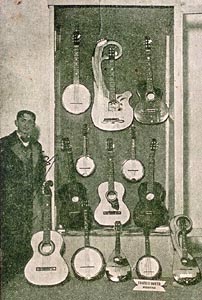
|
This 2010 article was the result of my friend Benoit Meulle-Stef simultaneously obtaining the incredible advertisement flyer at right and discovering additional information on the Italian Fetish Guitars web site. My title has a double meaning. The first is in reference to the obvious rarity - another prolific guitar and harp guitar maker virtually unknown outside their home country and only "unearthed" in 2009! The second meaning is from the fascinating fact that the "Aguila" model (seen in photo at left, and specimen below) was physically buried for protection for years. Built in 1922, it was taken apart in the early 1940's and buried in waterproof wrappings to prevent it being discovered and appropriated by the occupying Germans during the war. It was later dug up, and in 1983 was re-assembled by a grandson of the original builder. Talk about a "time capsule" guitar! My information for this article comes from the article by Marco Ballestri on the fetishguitars.com web site, and assembled from many sources. I am somewhat crudely translating and subsequently paraphrasing it for English-speaking Harpguitars.net readers. |
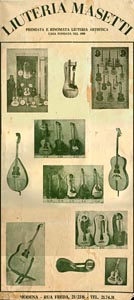
|
|
The "Fratelli Masetti" (Masetti Brothers) shop was founded in Modena in 1900 by brothers Romolo and Primo. They reached a great level of success, winning awards at expositions in Rome, Florence and other cities in 1922, 1926, 1927 and 1929. Primo also took advantage of collaborations with the outstanding musicians Primo Silvestri, mandolinist, and Romolo Ferrari, president of the Association Chitarristica Internzionale (Ferrari - himself a guitar student of Mozzani - is recently the subject of an in-depth collaborative Italian book). Through Ferrari, the Masetti brothers were introduced to Andrés Segovia in 1936, and collaborated on a new guitar of maple and fir known as the “Segovia Model.” Between 1927 and 1935, Primo's sons Renzo and Walter began to work in the shop. Renzo specialized in finishing techniques, experimenting with new formulas, while Walter - a student of Romolo Ferrari, graduating in 1937 from the Academy Chitarristica Mandolinistica in Milan - contributed substantially to achieving new goals in acoustical properties. Primo passed away in 1939, and in 1942, the shop was forced to close due to the war - though some activity still took place, known from the existence of dated 1943 and 1944 guitars. The instruments in inventory were all hidden during this time, as the Masetti's were fearful of raids, and so special was their now-20-year-old mezza-lyra Aquila (one-armed harp guitar) instrument that they took it apart, wrapped it in waterproofed burlap and buried it in the house's garden. It would be reassembled in 1983 by Roberto Masetti, Walter's son and Primo's grandson. The shop re-opened after the war, now with Romolo and Primo's two sons. In 1951, Walter's son Roberto joined the firm. During this era, Walter and Renzo began to create new, modern instruments based on their study of the various Gibson amplified semi-acoustic jazz archtops. Additional medals and awards were won in 1956 and 1957. In 1976, Renzo retired, Walter following in 1980, leaving the shop to Roberto, who continued to develop and produce new instruments until 1999 under a new “Liuteria Masetti” label. A nearly 100-year legacy! An obvious similarity to Mozzani features and visual designs is found in the (early) Masetti instruments - including the rectangular thin and wide neck, and floating neck adjustment system on the hollow arm lyra harp guitars. Masetti author Marco Ballestri wonders who influenced or copied whom, as there doesn't seem to be any direct evidence, and the two firms were contemporaries, introducing their models seemingly simultaneously. They were also in neighboring towns. In the case of the Aquila (Eagle) model, we know the date of the Masetti, while the Mozzani date is unknown - and in fact, has rumors of being created many years later specifically for famed troubadour Italo Meschi. Obviously, there is much to explore and resolve and surviving instruments to uncover in the "buried treasure" realm of Fratelli Masetti ! |
||
| Theorboed Harp Guitars | |||
|
There are two other Masetti's very similar to the above 3-sub-bass specimens on the "wall of guitars" section of the poster (see below). The design is very reminiscent of several other Italian harp guitar makers shown in the Gazzo study. |
|||
| Hollow Arm Harp Guitars (lyra and mezza-lyra forms, or “lyre” and “half-lyre” - or in harp guitar terms, “dual arm” and “single arm”) This group shows three fascinating knockoffs of Mozzani's famous harp guitars - or are they? Marco Ballestri points out that we still can't prove who copied whom. We don't know the specific timeline of the various models of either shop - Masetti or Mozzani (not to mention the several other concurrent Italian makers). The similarity between these Masetti designs and those of Mozzani is rather obvious. Note the body and arm shapes, the creative soundhole shapes (Masetti's lyre motif is unique to his instruments), the fancy bridges, floating, adjustable rectangular neck, and tuner arrangement. |
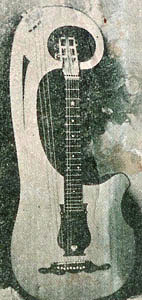 |
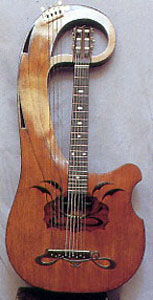 image from Fetish Guitars |
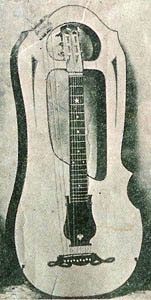 |
According to Marco Ballestri in his article on fetishguitars.com, the extant specimen in the center was originally built in 1922. This is before 1926 - the theoretical date that Italo Meschi obtained his Mozzani Aquila, which Harpguitars.net readers know is rumored to have been created specifically in his honor. Whether true or not, we don't know when the Mozzani Aquila first appeared (surely there is a date in at least one of the existing specimens?!). In Masetti's case, their model is not too different from their "standard" single-arm model (with lyre soundhole) - the "eagle feathers" effect being less obvious. However, the outrageous carved back is much more stunning (click on image). |
|||
| Harp Mandolins (hollow arm mandolins) |
| Labels |  image from Fetish Guitars |
|
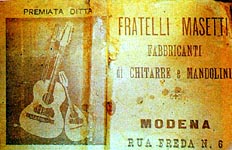 image from Fetish Guitars |
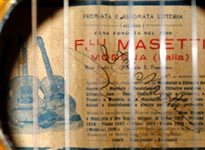 image from Fetish Guitars |
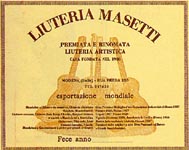 Post-1980 label image from Fetish Guitars |
|
Special thanks to Benoit Meulle-Stef and Franco Ghisalberti
|
|
|
|
All Site Contents Copyright © Gregg Miner, 2004,2005,2006,2007,2008,2009,2010,2011. All Rights Reserved. Copyright and Fair Use of material and use of images: See Copyright and Fair Use policy. |